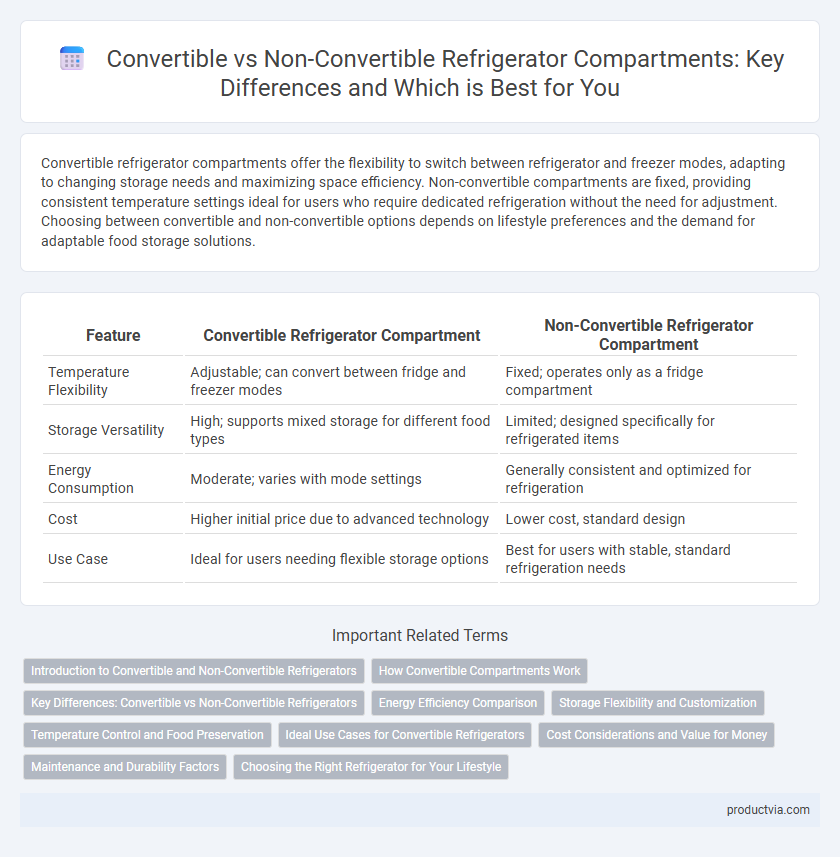Convertible refrigerator compartments offer the flexibility to switch between refrigerator and freezer modes, adapting to changing storage needs and maximizing space efficiency. Non-convertible compartments are fixed, providing consistent temperature settings ideal for users who require dedicated refrigeration without the need for adjustment. Choosing between convertible and non-convertible options depends on lifestyle preferences and the demand for adaptable food storage solutions.
Table of Comparison
| Feature | Convertible Refrigerator Compartment | Non-Convertible Refrigerator Compartment |
|---|---|---|
| Temperature Flexibility | Adjustable; can convert between fridge and freezer modes | Fixed; operates only as a fridge compartment |
| Storage Versatility | High; supports mixed storage for different food types | Limited; designed specifically for refrigerated items |
| Energy Consumption | Moderate; varies with mode settings | Generally consistent and optimized for refrigeration |
| Cost | Higher initial price due to advanced technology | Lower cost, standard design |
| Use Case | Ideal for users needing flexible storage options | Best for users with stable, standard refrigeration needs |
Introduction to Convertible and Non-Convertible Refrigerators
Convertible refrigerators feature adjustable compartments that shift between freezer and fridge modes, providing flexible storage options based on user needs. Non-convertible refrigerators maintain fixed freezer and fridge sections, offering consistent and dedicated temperature zones for specific food storage. This adaptability in convertible models enhances usability and energy efficiency compared to traditional non-convertible units.
How Convertible Compartments Work
Convertible refrigerator compartments utilize adjustable temperature controls to switch between freezer and fridge modes, offering versatile food storage solutions. These compartments maintain optimal cooling through advanced sensors and compressors that adapt cooling cycles based on selected settings. This flexibility enhances energy efficiency by tailoring cooling needs to stored items, reducing power consumption compared to dedicated freezer or refrigerator compartments.
Key Differences: Convertible vs Non-Convertible Refrigerators
Convertible refrigerators feature adjustable compartments that switch between freezer and fridge modes, offering versatile storage for varying food preservation needs. Non-convertible refrigerators have fixed compartments with dedicated freezer and fridge sections, ensuring consistent temperature control but less flexibility. The key difference lies in the adaptability of convertible models, which optimize space use by changing compartment functions based on user preferences.
Energy Efficiency Comparison
Convertible refrigerator compartments offer greater energy efficiency by allowing users to adjust temperature settings based on storage needs, reducing unnecessary power consumption compared to non-convertible compartments with fixed temperature zones. Non-convertible refrigerator compartments maintain consistent cooling cycles that can lead to higher energy usage when storing items that require less cooling. Energy Star-rated convertible models typically demonstrate lower annual kilowatt-hour (kWh) consumption, optimizing electricity costs and environmental impact.
Storage Flexibility and Customization
Convertible refrigerator compartments offer enhanced storage flexibility by allowing users to switch between freezer and refrigerator modes based on their needs, maximizing customization for varying food storage requirements. Non-convertible compartments have fixed temperature zones, limiting adaptability but providing consistent cooling performance optimized for specific food types. Selecting a convertible model is ideal for households with fluctuating storage demands, while non-convertible units suit those needing stable temperature settings for specialized items.
Temperature Control and Food Preservation
Convertible refrigerator compartments offer precise temperature control, allowing users to switch between freezer and fridge modes, optimizing food preservation for different types of items. Non-convertible compartments maintain a fixed temperature range, limiting flexibility but ensuring consistent conditions tailored specifically for either refrigeration or freezing. Enhanced temperature control in convertible models supports longer freshness and reduces food spoilage by adapting to varying storage needs.
Ideal Use Cases for Convertible Refrigerators
Convertible refrigerator compartments offer flexible temperature settings, allowing users to switch between fridge and freezer modes to accommodate varying storage needs. Ideal for households with fluctuating food storage requirements, they enable efficient preservation of fresh produce, frozen goods, or large quantities of chilled beverages. This adaptability makes convertible refrigerators particularly suitable for families, entertainers, and those who purchase groceries in bulk.
Cost Considerations and Value for Money
Convertible refrigerator compartments offer flexible temperature settings that can switch between fridge and freezer modes, providing customizable storage options with a generally higher price point. Non-convertible compartments are typically more affordable, delivering consistent cooling without the added functionality but may lack the adaptability to meet diverse storage needs. Evaluating cost considerations involves balancing the initial investment against long-term value, where convertible models often justify their premium through enhanced versatility and energy efficiency.
Maintenance and Durability Factors
Convertible refrigerator compartments feature flexible temperature settings that can adapt between fridge and freezer modes, offering enhanced versatility but requiring precise maintenance to ensure seals and cooling elements function correctly. Non-convertible compartments simplify durability concerns with fixed temperature zones, minimizing mechanical complexity and reducing the likelihood of component wear over time. Regular inspection of door gaskets and condenser coils is critical for both types, but convertible models demand more frequent calibration to maintain optimal performance and longevity.
Choosing the Right Refrigerator for Your Lifestyle
Convertible refrigerator compartments offer versatile temperature settings, allowing users to switch between freezer and fridge modes based on changing storage needs. Non-convertible compartments maintain a fixed temperature, providing consistent preservation ideal for users with stable storage preferences. Selecting between convertible and non-convertible refrigerators depends on lifestyle demands, such as meal planning frequency and space optimization.
Convertible vs Non-Convertible for Refrigerator Compartment Infographic

 productvia.com
productvia.com